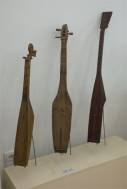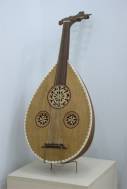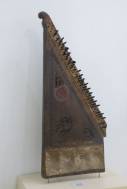Georgian music culture is acknowledged in many countries of the world. The existence of first-rate symphony orchestras, musical theatres in different cities, musical schools, distinguished original national school of composers seem unbelievable if one takes into account the fact that the academic music as understood under European standards counts only a number of decades. In fact it originated at the end of the XIX and the beginning of XX centuries. The prerequisite for the swift development lies in the high  potential and ancient history of the Georgian musical culture. The AD manuscripts give information on Georgian civilization - Sumerian cuneiform inscriptions mention the original musical rituals of the tribes residing on the territory of Georgia. The archaeological excavations revealed the ancient musical instruments, salamuri (pipe), changi (string instrument) etc. dated back to XVIII - XXV AD. The importance of music in the lives of Colchis and Iberians was stressed by ancient Greek historians Herodote, Xenophon, Strabone… potential and ancient history of the Georgian musical culture. The AD manuscripts give information on Georgian civilization - Sumerian cuneiform inscriptions mention the original musical rituals of the tribes residing on the territory of Georgia. The archaeological excavations revealed the ancient musical instruments, salamuri (pipe), changi (string instrument) etc. dated back to XVIII - XXV AD. The importance of music in the lives of Colchis and Iberians was stressed by ancient Greek historians Herodote, Xenophon, Strabone… Folk music, namely polyphonic choir performance traditions have a special place among the cultural values of the Georgian people. The Georgian folk music can be considered unique without any exaggeration in the world music culture.If we imagine the world music map, we shall see that Georgia is a polyphony oasis in the desert of monody, one part. Musical traditions The tradition of polyphony has been preserved from ancient times till today. Every region of Georgia has its own tradition of specific musical dialect and the manner of performance, none the less all of them share the same intonation and harmony characteristics. Here the parallel can be made with the diverse nature of the country. It is the style that occurs in three specific forms from: the complex polyphony found in Svaneti, whereby all the voices follow the same rhythmic pattern, producing choral progression; the polyphonic dialogue typical of  Eastern Georgia with two high voices over a drone bass; and the contrastive polyphony widespread in Western Georgia and characterized by predominantly three-part writing. Georgian folk songs are generally written in three-part polyphony, though four-part writing is also found, as is clear from Gurian and Adzharian work songs. Unison singing has survived in a few mountainous regions such as those inhabited by the Khevsurians and Tushetians, and individual examples of monophonic songs are occasionally found in both Western and Eastern Georgia. They include work, cradle, burial and mourning songs and are sometimes accompanied by native instruments. Eastern Georgia with two high voices over a drone bass; and the contrastive polyphony widespread in Western Georgia and characterized by predominantly three-part writing. Georgian folk songs are generally written in three-part polyphony, though four-part writing is also found, as is clear from Gurian and Adzharian work songs. Unison singing has survived in a few mountainous regions such as those inhabited by the Khevsurians and Tushetians, and individual examples of monophonic songs are occasionally found in both Western and Eastern Georgia. They include work, cradle, burial and mourning songs and are sometimes accompanied by native instruments. It is natural that the rich musical tradition gave birth to the professional ecclesiastic music right after the introduction of Christianity in Georgia (4th century). This genre was especially developed in local ecclesiastic academies and schools (Gelati, Ikalto) and the Georgian cultural centers abroad (Jerusalem, Athoni, mount Sina, Petritsoni (Bulgaria)). The collection of hymns of VIII-X centuries (the most famous of which are the hymns of Michael Modrekili of IX-X cc.) provide with the wide variety of texts and original musical symbols. Georgian and foreign researchers are working to decipher them. All these songs reflect the creative imagination of the Georgian nation, its highly developed auditory sensitivity and complex and sophisticated musical thinking. It is no accident that in 1977 a recording of the song Chakrulo was launched into space on board an American space probe as an example of humanDue to historical and political situation Georgian culture was cut from the main stream of development of the European musical culture. Only in the XIX century despite the annexation of Georgia by Russia and the subsequent colonial policy and Russification, Georgia began to develop its academic national musical culture with the orientation to the civilization. European music. The acquaintance with the European opera brought about the development of this genre and in a number of years the national operas were created by the composers Z. Paliashvili, M. Balanchivadze, D. Arakishvili and V. Dolidze. The 20ies - 30ies of the 20th century were marked by the development of chamber and symphony music genres. Georgian Congregational Song  Christianity became the state religion of Georgia in the first half of 4th century, in 326. Since that time, Christian cathedrals are built and divine services are conducted and, accordingly, Christian church singing began. Originally, Georgian church singing underwent foreign influence. That influence came from Palestine and Syria, on the one hand, and Byzantine, on the other hand. But the original hymnographical patterns are created since the 5th century. Georgian church singing of the 7th century was already liberated from foreign influence. The stream of polyphony came into church singing, that caused nationalization of Georgian songs of wordship. This process was based on the abundance of the elements of folk music, which depended more in the following centuries. PROFESSIONAL MUSIC The originality of Georgian musical culture is an absolute fact for everybody even slightly acquainted with it. As an inseparable part of the national culture since times immemorial it has shown the current processes in the everyday and spiritual life, in the thinking and artistic imaginations of the Georgian i tribes first and then of the Georgian nation. Culture in general, as well as Georgian culture, is a collective phenomenon and, as it is said, it comprises its own present, past and future; it has a memory, which guarantees the continuity of its traditions Tin- history of Georgian musical culture-the be-ginning of which is lost in the depths of millennia, and the result of which-the highly developed many-voiced singing, is the pride of the Georgian nation, is its proof as well. This history of developed so that in the periods of ancient pagan and the following early Middle Ages culture maintained active relations with the civilizations of the ancient Mediterranean area, then with the antique civilian ions and at last with the Christian civilizations. It is not difficult to trace the relations in the similarity, which depicts the ideas of fighting with Gods and gaining fire in the Sumerian "Gilgameshiani", 3rd millennium BC, in the Georgian "Amiraniani", 2nd millennium BC and in the Greek myth about Prometheus at a later period. The monuments of the material culture of the same period prove that the theatrilized religious mysteries and cult-rituals born in the world-outlook imaginations and artistic thinking of our ancestors were factually the same as the world-outlook expressed in the typical forms of the then Near East-Old Egyptian, Sumerian-Babylonian, Palestinian (Old Hebrew) and Mycenaean cultures. The corroboration of the existence of the Perkhulis (round dance) of those times are of particular importance for us (the circle, as a symbol of the wholeness and perfection of the universe), and the archaic musical-choreographic ritual acts preserved up to the present times in one of the most ancient parts of Georgia-the mountainous Svaneti, and among them the so-called "Amiran's Perkhulis" with many-voiced singing, which clearly shows the continuous heredity of the Georgian musical culture. There are different opinions about the Georgian singing being many-voiced as early as in the pagan period. An interesting supposition is expressed by N. Mamisashvili, that the original system of the Georgian traditional musical thinking, whose peculiarity is the extension of sounds in the double-quintal-quarter "special diameter" must have been established at the junction of the 6th-5th centuries BC. On the basis of written sources we can already speak of "the originality of a peculiar kind" (Xenophon, 6th-5th c. BC) of war-songs or Perkhuli songs sung by the ancestors of Georgians. Whether this "peculiarity" meant only many-voiced singing for the Greek historian, whose ear was accustomed to listening to unison songs, cannot be proved, but one thing is a fact, that this "peculiar" singing tradition, many centuries later, in the 10th-11th c.c. of the Common Era preconditioned the original form of the unique many-voiced church chant in the whole Christendom of those times. A new stage of the development of Georgian musical culture began by declaring Christianity the state religion (4,h c. AD). From that time on Georgian people have always had to fight to defend their national sovereignty. The lot, so typical for a small country, was especially hard for Georgia, being surrounded by the countries of quite different cultural orientations, it had to pay hard for the relationship not only with openly hostile forces, such as Iranians, Arabs, Mongols or Turks, but with the countries of the kindred cultural and religious conception as well, for example, in the remote past with Bizantium and for the last two centuries with Russia. In such relationships with this multifarious world Georgian Christian culture, as well as its musical culture, was being shaped, the latter formed a new channel parallel to the old one in the national musical consciousness and from the 4lh-5lh centuries AD the professional compositional system of thinking was started, which was different from folklore. This was a qualitatively new phenomenon for the artistic-aesthetic world of Georgians. It originated from that model of relationships of cultures, according to which it is easier for the established original culture to assimilate an alien tradition. This process was taking place in Georgia under the badge of the conception of Byzantine or rather general Christian culture by the national culture, and it was penetrating into every sphere, from the mode of everyday life including architecture, literature and music. At the same time the national consciousness tried to establish new cultural values in an assimilated way on the basis of national traditions. This is manifested in the monumerits of the Georgian literature and architecture of pre-Christian times, but in our opinion, the idea of national originality was no less vividly expressed in music. What we now call the old professional Georgian music is a highly developed vocalic polyphony. It is actually the result of the perception of Byzantine Christian monadic hymns by the Georgian pagan many-voiced singing culture. The one-voiced Byzantine chant, whose origin can be found in Old Hebrew hymns and which came to Georgia together with the rules of the divine service, gradually received many-voiced forms usual for the Georgian musical thinking. The compositional-technological logic of music was mainly based on the system of eight voices established in the orthodox church practice by John of Damascus. Eleven manuscripts of the 10th-13th centuries hymnography selections reached us; their texts are marked by the original musical signs which are different from those of Byzantium. It is known that three Georgian manuscripts found in the monastery on Mt. Sinai at the beginning of the 20th century. Unfortunately, like those of Paleobyzantine ones, the Georgian musical neums of the early Middle Ages have not been deciphered yet. The latest researches in music (M. Khvtsiashvili) showed that in the practice of the autocephaly Georgian Church there existed such highly developed liturgic-musical sincrietic forms as, for instance, "Passion"-a musical setting of the Biblical story of Christ's death. The classical three-part vocal polyphony was already established in the 10lh-11lh centuries. The Georgian Theo philosophical teaching (Ioane Petritsi), which explains the principle of the wholeness of the Christian Trinity by the analogy of the merging of three-voices in the Georgian singing, is a proof of it; it is also noteworthy that the classical period of the Old Georgian professional music coincided with the "Golden Age" of the Georgian culture, national statehood and world-outlook and artistic thinking. Culture, as a system, is an integral phenomenon. It is only natural that Georgian church music, an integral part of Georgian hymnography, which was highly developed at that time, should have attained its classical perfection together with poetry. We think that polyphony is one of the main features of the Georgian traditional artistic thinking generally. It is shown not only in Petritsi's understanding of the Divine Trinity, but also in the Georgian linear writing and in the ability of Rustaveli to see the universe in "countless colors", but polyphony is, first of all, a category of musical thinking and that is why it was most perfectly expressed in the nation's musical perception of the universe. It is in the polyphony, that the idea of the heredity of the Georgian traditional musical thinking was expressed, it is in the polyphony that the wholeness of the pre-Christian and Christian musical world perception is reflected. Thus, we may say, that Old Georgian professional music-the Georgian vocal polyphony generally expresses the national- musical consciousness but at the same time it is a symbol of the concrete Christian-epoch musical consciousness and it is an original phenomenon in the whole Christian musical culture, imprinted by such spiritual and moral peculiarities by which the Georgian nation enriched the treasury of the art of mankind. Unfortunately, mankind knows very little about this acquisition as yet. The memory of the national musical culture preserved the knowledge of vital importance about the historically established artistic-aesthetic orientation of its own. This is the very knowledge that conditions its choice at the decisive stages of history. After adopting Christianity the Georgian nation often faced the danger of physical destruction, but it never betrayed the once chosen European orientation. The same happened at the end of the 18th century, when Georgia, weakened by her endless struggles for physical and spiritual survival, sought an ally in Russia, the country of the same religion. Today it is impossible to estimate this fact in a simple way even from the point of view of Georgian musical culture; on the one hand, Georgian lost its sovereignty, Georgian church had become auto cephalic as early as the 5lh century; such strong symbols of the Georgian national-cultural originality as the Georgian word and the Georgian chant were banished. At the same time the compositional-technological conception of the old professional music sank into oblivion. On the other hand Georgian musical culture restored the age-long broken relations with European culture through Russia. The notation of folk-songs and several thousands of ecclesiastic chants, which had been preserved by oral tradition for millennia, became possible. A solid foundation was laid for the professional musical education, which soon became systematic and was crowned by opening a higher musical institution-a conservatoire in 1917. But while the small Georgian nation, living on the border of Europe and Asia, was fighting a desperate fight for saving the cultural values which had passed through centuries, as well as for preserving and protecting the original folk and professional polyphony, European musical culture reached unprecedented levels by natural evolutionary development. All this was to be taken into consideration by the culture that was historically oriented to the European culture. That is why it is not difficult to explain a special interest of the Georgian musical thinking of traditionally polyphonic structure in the highly developed many-voiced European music. Beginning from the latter half of the 19th century Tbilisi was the most important musical and cultural center of the Russian Empire. The second large town-Kutaisi was distinguished by its intensive musical life as well. Thus, the establishing of the new Georgian musical culture of the European kind was preceded by the opening of the Opera House in 1851, which hosted first the Italian and then Russian companies; the musical-educational activities of Russian musicians, fruitful relations with other layers of European music-catholic music, German, Polish, French music, the richest experience of relations with the Oriental musical culture. In short, by the beginning of the 20lh century Georgian musical culture had acquired a wide range of vision. This gave it a possibility to choose its own way of development; for instance, the desire to create a national opera was not only merely the desire to bring this genre, so popular in Europe, to Georgia. This was the desire of the highly developed folk and professional singing culture to give a new life to the traditional musical idea under new conditions. All that happened in the new Georgian professional music during one century (the first specimens of artistic value of the new Georgian music-M. Balanchivadze's romances, were created in 1889) show the fastest evolution of the national composition thinking. The establishment of the European vocal, vocal-instrumental or purely instrumental forms and genres in the Georgian musical thinking meant significant changes, such as the breaking up of the traditional non-tempered system of the sound order, the combining of modal relations with tonal ones, and as a whole, the creation of such a new timbre-into-national word which would be genetically connected with the age-long folk and professional musical tradition; and, at the same time it should reflect the modern world-outlook of the Georgian nation, which had already shared the modern cultural experience. Taking into consideration all this enabled Zakaria Paliashvili to perfectly realize the symbolic idea of the national spirituality in his immortal opera "Abesalom and Eteri" (1919) and at the same time to give his opera a supranational, general meaning. The same qualities characterize the choral creations of Niko Sulkhanishvili. In short, the classics of the new Georgian music: Meliton Balanchivadze, Dimitry Araqishvili, Viktor Dolidze, Niko Sulkhanishvili and Zakaria Paliashvili started and created classical heritage in the vocal genres: romance, opera, choral music. From the 20s of our century, when the so-called Soviet period, lasting seventy years, began, the new generation of Georgian composers set a goal to establish instrumental genres and in the following decades this aim was achieved successfully. By and by the multifariousness of the genres of Georgian music and the main artistic-aesthetic tendencies became clear-cut, the technological conception was established, which benefited mainly from the achievements of the Russian-European classical-romantic musial art, but at the same time revealed the individual style of separate composers. In the 30s and 40s new representatives of Georgian music appeared, who created many works in different genres. They have already become classical works of our national music. We must mention Andria Balanchivadze and Shalva Mshvelidze in symphony, Shalva Mshvelidze and Otar Taktakishvili in opera oratorio, Andria Balanchivadze, David Toradze and Alexi Machavariani in ballet, Sulkhan Tsintsadze in instrumental chamber music. Revaz Laghidze and David Toradze in songs, Mary Davitashvili in children's music, etc. The 60s for Georgian music were the turning point in style and a new stage of development started. It is not difficult to find the determinant of this qualitative leap. On the boundary of the 50s and 60s in the whole area of the Soviet ideology the tendency of liberalization grew stronger and the so-called "thawing" relief was felt by Georgian music as well-it escaped the demand of reflecting the conflict less reality and got acquainted with the richest experience of the musical practice of the 20th century. This was a new vision of the world expressed by technological innovation. Individual composition thinking gets free of all the conventionality and it becomes possible to use any technique of composition or means of expression suitable for the artistic aim. In short, the current processes in Georgian music from the 60s up to the present day have two sides: its charm is in the widening of the scope of musical culture, in striving towards something that is common to all mankind, to generally ethical, to generally aesthetic values. At the same time there is a danger that the integration of different musical cultures may result in wiping out the peculiarity, that distinguishes national musical styles from each other; that would certainly impoverish the practice of the world musical creativity. However, as it seems, the very dialectic nature of this process removes this danger-the works of the composers who began their creative work in the 60s, such as Bidzina Kvemadze, Sulkhan Nasidze, Gia Qancheli, Nodar Gabunia, Phillip Ghlonti, Nodar Mamisashvili, Ioseb Kechaqmadze, Vazha Azarashvili, and those of the following generation: Temur Bakuradze, Ioseb Bardanashvili, Zurab Nadareishvili and others, show that in the intensive interaction of musical cultures the ability of the traditional symbolic culture-to survive in the qualitatively new conditions-appears to be rather strong. The national-specific nature is shown from a new angle, whose existence at this stage of development is revealed not only and not so much in separate principles of forming structures but on the conceptual level as well. To illustrate the above we shall give one example out of many: they say that Gia Qancheli became familiar with a lot of style sources in his time, in the processes of establishing his technique as a composer the specific contribution of the all-European experience was rather great. The composer himself confesses that he tries not to use folklore directly. Nevertheless his music is perceived as "the confession of the Georgian people, of the son of the Georgian land, because the history of the people is seen in his music, the national character, the language and the peculiarity of speech are felt; the inner pride of a great culture, a good stature, some kind of brilliance, tenderness and manliness are reflected" (Rodion Shchedrin). Only that music can be perceived like this whose sources of style are based on the "first experience", "first image", archetype of the national music established in the collective sub consciousness and repeated many a time at different stages of the millennial history. That is why only those people are able to perceive G. Qancheli's music like this who know, even superficially, the Georgian musical folklore, those who have certain knowledge about the past of Georgian culture and about the present time. But to those listeners, who can not perceive G. Kancheli's music in the context of national culture, he still remains a creator "of a different cultural circle", who at the same time "masters the European compositional technique marvelously". Of the first impression of a music critic from Warsaw, who listened to G. Qancheli's sixth symphony, the most noteworthy for us is the fact, that the music critic acknowledged that he had encountered something "different", i.e. he had a feeling of something original, unknown until then. And this is the acknowledgment of this style as an artistic-aesthetic fact, because the national style is revealed only in comparison with other styles and, as it is generally remarked, "is born of comparison". It is quite a different question that the modern world knows very little about the new or old Georgian musical style. One of the aims of the relations of cultures is to get acquainted with the achievements of other cultures, and fortunately today's contacts offer such possibilities. |
|
| "M U L T I T U R" | Среда, 16.07.2025, 7:57:14 Приветствую Вас Гость | RSS |

 |
Главная | Georgian Music | Регистрация | Вход |  |















